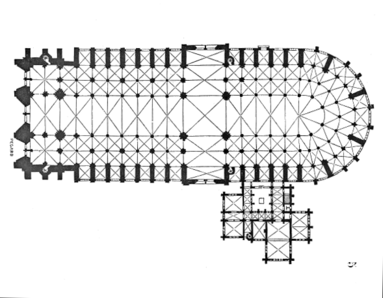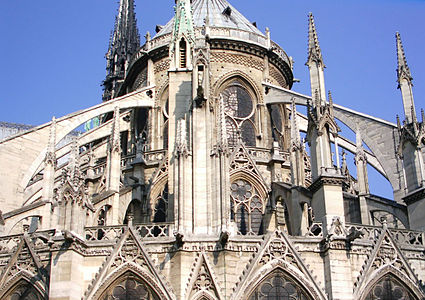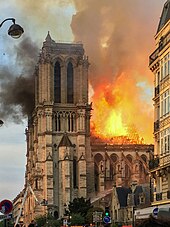"Our Lady of Paris", often referred to simply as Notre-Dame, is a medieval Catholic cathedral on the Île de la Cité in the 4th arrondissement of Paris, France. The cathedral is considered to be one of the finest examples of French Gothic architecture. Its innovative use of the rib vault and flying buttress, its enormous and colourful rose windows, and the naturalism and abundance of its sculptural decoration set it apart from the earlier Romanesque style.
The cathedral was begun in 1160 under Bishop Maurice de Sully and was largely complete by 1260, though it was modified frequently in the ensuing centuries. In the 1790s, Notre-Dame suffered desecration during the French Revolution; much of its religious imagery was damaged or destroyed. In 1804, the cathedral was the site of the Coronation of Napoleon I as Emperor of France, and witnessed the baptism of Henri, Count of Chambord in 1821 and the funerals of several presidents of the Third French Republic.
Popular interest in the cathedral blossomed soon after the publication, in 1831, of Victor Hugo's novel The Hunchback of Notre-Dame. This led to a major restoration project between 1844 and 1864, supervised by Eugène Viollet-le-Duc, who added the cathedral's iconic spire. The liberation of Paris was celebrated within Notre-Dame in 1944 with the singing of the Magnificat. Beginning in 1963, the façade of the cathedral was cleaned of centuries of soot and grime, returning it to its original color. Another cleaning and restoration project was carried out between 1991 and 2000.
The cathedral is one of the most widely recognized symbols of the city of Paris and the French nation. As the cathedral of the Archdiocese of Paris, Notre-Dame contains the cathedra of the Archbishop of Paris(Michel Aupetit). 12 million people visit Notre-Dame annually, making it the most visited monument in Paris.
While undergoing renovation and restoration, the cathedral caught fire on 15 April 2019 and sustained significant damage, including the destruction of the spire and two-thirds of the roof.[1] French President Emmanuel Macron announced that Notre-Dame will be rebuilt, stating "It's part of the fate, the destiny of France, and our common project over the coming years. And I am committed to it."
History
It is believed that before the period of Christianity in France, a Gallo-Roman temple dedicated to Jupiterstood on the site of Notre-Dame. Evidence for this is the Pillar of the Boatmen, discovered in 1710. This building was replaced with an Early Christian basilica. It is unknown whether this church, dedicated to Saint Stephen, was constructed in the late 4th century and remodeled later, or if it was built in the 7th century from an older church, possibly the cathedral of Childebert I.The basilica, later cathedral, of Saint-Étienne was situated about 40 metres (130 ft) west of Notre-Dame's location and was wider and lower and roughly half its size. For its time, it was very large—70 metres (230 ft) long—and separated into naveand four aisles by marble columns, then decorated with mosaics.
A baptistery, the Church of John the Baptist, built before 452, was located on the north side of the church of Saint-Étienne until the work of Jacques-Germain Soufflot in the 18th century.Four churches succeeded the Roman temple before Notre-Dame. The first was the 4th century basilica of Saint-Étienne, then the Merovingian renovation of that church which was in turn remodeled in 857 under the Carolingiansinto a cathedral. The last church before the cathedral of Notre-Dame was a Romanesque remodeling of the prior structures that, although enlarged and remodeled, was found to be unfit for the growing population of Paris.
In 1160, the Bishop of Paris, Maurice de Sully, decided to build a new and much larger church. He summarily demolished the Romanesque cathedral and chose to recycle its materials. Sully decided that the new church should be built in the new Gothic style, as by then a number of large Gothic cathedrals had already been raised elsewhere in France
Initial construction
The chronicler Jean de Saint-Victor recorded in the Memoriale Historiarum that the construction of Notre-Dame began between 24 March and 25 April 1163 with the laying of the cornerstone in the presence of King Louis VII and Pope Alexander III.Four phases of construction took place under bishops Maurice de Sully and Eudes de Sully (not related to Maurice), according to masters whose names have been lost or were not recorded.
The first phase began with the construction of the choir and its two ambulatories. According to Robert of Torigni, the choir was completed in 1177 and the high altar consecrated on 19 May 1182 by Cardinal Henri de Château-Marçay, the Papal legate in Paris, and Maurice de Sully.The second phase, from 1182 to 1190, concerned the construction of the four sections of the nave behind the choir and its aisles to the height of the clerestories. It began after the completion of the choir but ended before the final allotted section of the nave was finished. Beginning in 1190, the bases of the facade were put in place, and the first traverses were completed.
The decision was made to add a transept at the choir, where the altar was located, in order to bring more light into the center of the church. The use of simpler four-part rather than six-part rib vaults meant that the roofs were stronger and could be higher. After Bishop Maurice de Sully's death in 1196, his successor, Eudes de Sully (unrelated to the previous Bishop) oversaw the completion of the transepts, and continued work on the nave, which was nearing completion at the time of his own death in 1208. By this time, the western facade was already largely built, though it was not completed until around the mid-1240s. Between 1225 and 1250 the upper gallery of the nave was constructed, along with the two towers on the west facade.
Another significant change came in the mid-13th century, when the transepts were remodeled in the latest Rayonnant style; in the late 1240s Jean de Chellesadded a gabled portal to the north transept topped off by a spectacular rose window. Shortly afterwards (from 1258) Pierre de Montreuil executed a similar scheme on the southern transept. Both these transept portals were richly embellished with sculpture; the south portal features scenes from the lives of St Stephen and of various local saints, while the north portal featured the infancy of Christ and the story of Theophilus in the tympanum, with a highly influential statue of the Virgin and Child in the trumeau. Master builders Pierre de Chelles, Jean le Bouteiller, and Raymond du Templesucceeded de Chelles and de Montreuil and then each other in the construction of the cathedral.
An important innovation in the 13th century was the introduction of the flying buttress. Before the buttresses, all of the weight of the roof pressed outward and down to the walls, and the abutments supporting them. With the flying buttress, the weight was carried by the ribs of the vault entirely outside the structure to a series of counter-supports, which were topped with stone pinnacles which gave them greater weight. The buttresses meant that the walls could be higher and thinner, and could have much larger windows. The date of the first buttresses is not known with any precision; they were installed some time in the 13th century. The first buttresses were replaced by larger and stronger ones in the 14th century; these had a reach of fifteen meters between the walls and counter-supports.
John of Jandun recognized the cathedral as one of Paris's three most important buildings [prominent structures] in his 1323 Treatise on the Praises of Paris:
| “ | That most glorious church of the most glorious Virgin Mary, mother of God, deservedly shines out, like the sun among stars. And although some speakers, by their own free judgment, because [they are] able to see only a few things easily, may say that some other is more beautiful, I believe however, respectfully, that, if they attend more diligently to the whole and the parts, they will quickly retract this opinion. Where indeed, I ask, would they find two towers of such magnificence and perfection, so high, so large, so strong, clothed round about with such a multiple variety of ornaments? Where, I ask, would they find such a multipartite arrangement of so many lateral vaults, above and below? Where, I ask, would they find such light-filled amenities as the many surrounding chapels? Furthermore, let them tell me in what church I may see such a large cross, of which one arm separates the choir from the nave. Finally, I would willingly learn where [there are] two such circles, situated opposite each other in a straight line, which on account of their appearance are given the name of the fourth vowel [O] ; among which smaller orbs and circlets, with wondrous artifice, so that some arranged circularly, others angularly, surround windows ruddy with precious colors and beautiful with the most subtle figures of the pictures. In fact I believe that this church offers the carefully discerning such cause for admiration that its inspection can scarcely sate the soul. | ” |
| — Jean de Jandun, Tractatus de laudibus Parisius[ | ||
Modern history
In 1548, rioting Huguenots damaged some of the statues of Notre-Dame, considering them idolatrous. During the reigns of Louis XIV and Louis XV, the cathedral underwent numerous alterations to comply with the more classical style of the period. The sanctuary was re-arranged; the choir was largely rebuilt in marble, and many of the stained-glass windows from the 12th and 13th century were removed and replaced with white glass windows, to bring more light into the church. A colossal statue of St Christopher, standing against a pillar near the western entrance and dating from 1413, was destroyed in 1786. The spire, which had been damaged by the wind, was removed in the second part of the 18th century.
In 1793, during the French Revolution, the cathedral was rededicated to the Cult of Reason, and then to the Cult of the Supreme Being. During this time, many of the treasures of the cathedral were either destroyed or plundered. The twenty-eight statues of biblical kings located at the west façade, mistaken for statues of French kings, were beheaded.Many of the heads were found during a 1977 excavation nearby, and are on display at the Musée de Cluny. For a time the Goddess of Liberty replaced the Virgin Mary on several altars. The cathedral's great bells escaped being melted down. All of the other large statues on the facade, with the exception of the statue of the Virgin Mary on the portal of the cloister, were destroyed. The cathedral came to be used as a warehouse for the storage of food and other non-religious purposes.
In July 1801, the new ruler, Napoleon Bonaparte, signed an agreement to restore the cathedral to the Church. It was formally transferred on 18 April 1802. It was the setting of Napoleon's coronation as Emperor on 2 December 1804, and of his marriage to Marie-Louise of Austria in 1810.
19th century reconstruction
The cathedral was functioning in the early 19th century, but was half-ruined inside and battered throughout. In 1831, the novel Notre-Dame de Paris by Victor Hugo, published in English as The Hunchback of Notre-Dame had an enormous success, and brought the cathedral new attention. In 1844 King Louis Philippeordered that the church be restored. The commission for the restoration was won by two architects, Jean-Baptiste-Antoine Lassus and Eugène Viollet-le-Duc, who was then just 31 years old. They supervised a large team of sculptors, glass makers and other craftsmen who remade, working from drawings or engravings, the original decoration, or, if they did not have a model, adding new elements they felt were in the spirit of the original style. They made a taller and more ornate reconstruction of the original spire (including a statue of Saint Thomas that resembles Viollet-le-Duc), as well as adding the sculpture of mythical creatures on the Galerie des Chimères. The restoration took twenty five years.
During the liberation of Paris in August 1944, the cathedral suffered some minor damage from stray bullets. Some of the medieval glass was damaged, and was replaced by glass with modern abstract designs. On 26 August, a special mass was held in the cathedral to celebrate the liberation of Paris from the Germans; it was attended by General Charles De Gaulle and General Philippe Leclerc.
In 1963, on the initiative of culture minister André Malraux and to mark the 800th anniversary of the Cathedral, the facade was cleaned of the centuries of soot and grime, restoring it to its original off-white color.
Artwork, relics, and other antiques stored at the cathedral include the supposed crown of thorns which Jesus wore prior to his crucifixion and a piece of the cross on which he was crucified, a 13th-century organ, stained-glass windows, and bronze statues of the 12 apostles.
Modern renovations
The stone masonry of the cathedral's exterior had deteriorated in the 19th and 20th century due to increased air pollution in Paris, which accelerated erosion of decorations and discolored the stone. By the late 1980s, several gargoyles and turrets had also fallen off or become too loose to remain in place.[28] A decade-long renovation program began in 1991 and replaced much of the exterior, with care given to retain the authentic architectural elements of the cathedral, including rigorous inspection of new limestone blocks. A discreet system of electrical wires, not visible from below, was also installed on the roof to deter pigeonsThe cathedral's pipe organ was upgraded The west face was cleaned and restored in time for millennium celebrations in December 1999.
The set of four 19th-century bells atop the northern towers at Notre-Dame were melted down and recast into new bronze bells in 2013, to celebrate the building's 850th anniversary. They were designed to recreate the sound of the cathedral's original bells from the 17th century.Despite the 1990s renovation, the cathedral had continued to show signs of deterioration that prompted the national government to propose a new renovation program in the late 2010s.The entire renovation was estimated to cost 100 million euros, which the Archbishop of Paris planned to raise through funds from the national government and private donations. A €6 million renovation of the cathedral's spire began in late 2018 and continued into the following year, requiring the temporary removal of copper statues on the roof and other decorative elements days before the April 2019 fire.
2019 fire
On 15 April 2019 at 18:50 local time the cathedral caught fire, causing the collapse of the spire and the oak roof. Both towers were safe. The extent of the damage was initially unknown, as was the cause of the fire, though it speculated that it was linked to ongoing renovation work.
French President Emmanuel Macron said approximately 400 firefighters helped to battle the fire. One firefighter was seriously injured during the blaze.
Many artifacts were saved before the fire spread to other parts of the cathedral. Because of the ongoing renovation, the copper statues that were normally on the now collapsed spire had been removed from the building The stone vaulting which forms the ceiling of the cathedral remained largely intact, preventing the burning timbers falling into the building below.
The billionaire François-Henri Pinault announced plans to pledge €100 million towards renovation and called for a joint effort to fund repairs. Soon after, LVMH owner and billionaire Bernard Arnault and his family pledged another €200 million for the restoration of "this extraordinary cathedral, which is a symbol of France









No comments:
Post a Comment